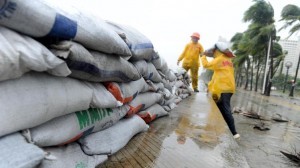
pile sand bags along the sea wall of Roxas Boulevard as Typhoon Rammasun hit Metro Manila on July 16, 2014. (MNS photo)
MANILA (Mabuhay) — Typhoon “Jose” weakened slightly while changing its movement from west-northwest to northwest direction at mid-morning Monday, according to the Philippine Atmospheric, Geophysical and Astronomical Services Administration (PAGASA).
The state weather bureau said that as of 10 a.m., the eye of typhoon “Jose” was located based on all available data at 880 kilometers east-southeast of Aparri, Cagayan (16.8°N, 130.6°E).
PAGASA said the typhoon’s maximum sustained winds decreased from 195 kph to 185 kph while its gustiness declined from 230 kph 220 kph.
It added that its movement also changed from west- northwest to northwest as it accelerated from 11 kph to 15 kph.
If it maintains its movement, PAGASA said typhoon “Jose” is expected to be at 840 km east-northeast of Aparri, Cagayan by Tuesday morning and at 810 km east-northeast of Basco, Batanes by Wednesday morning.
By Thursday morning, it is expected to be at 980 km northeast of Basco, Batanes or at 250 km east of Okinawa, Japan.
The weather bureau said the typhoon is still not directly affecting the country.
As it is not expected to make landfall, no public storm warning signal has been raised in any part of the country.
However, PAGASA said the typhoon continues to enhance the southwest monsoon — the prevailing wind system during the rainy season — and will bring monsoon rains over the Ilocos Region and Central Luzon.
On the other hand, Metro Manila, Calabarzon (Cavite, Laguna, Batangas, Rizal, Quezon) and Mimaropa (Mindoro, Marinduque, Romblon and Palawan) will have occasional rains.
The estimated rainfall amount is from 10 to 25 millimeters per hour (heavy to intense) within the 650-km diameter of the typhoon.
The weather agency said fisherfolks and those with small sea crafts are advised not to venture out over the northern and western seaboards of Luzon and the eastern seaboard of Southern Luzon. (MNS)